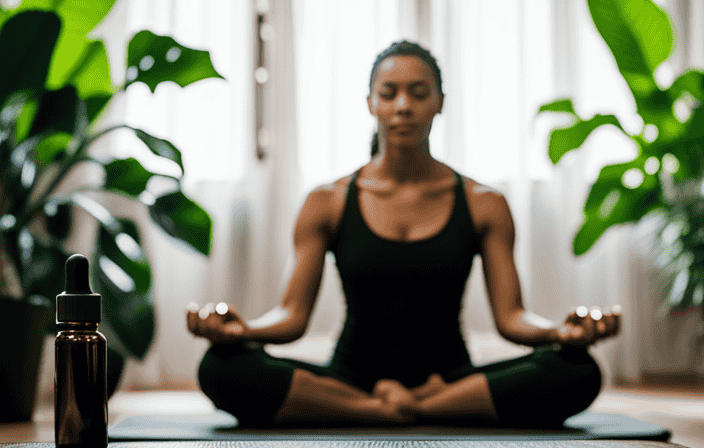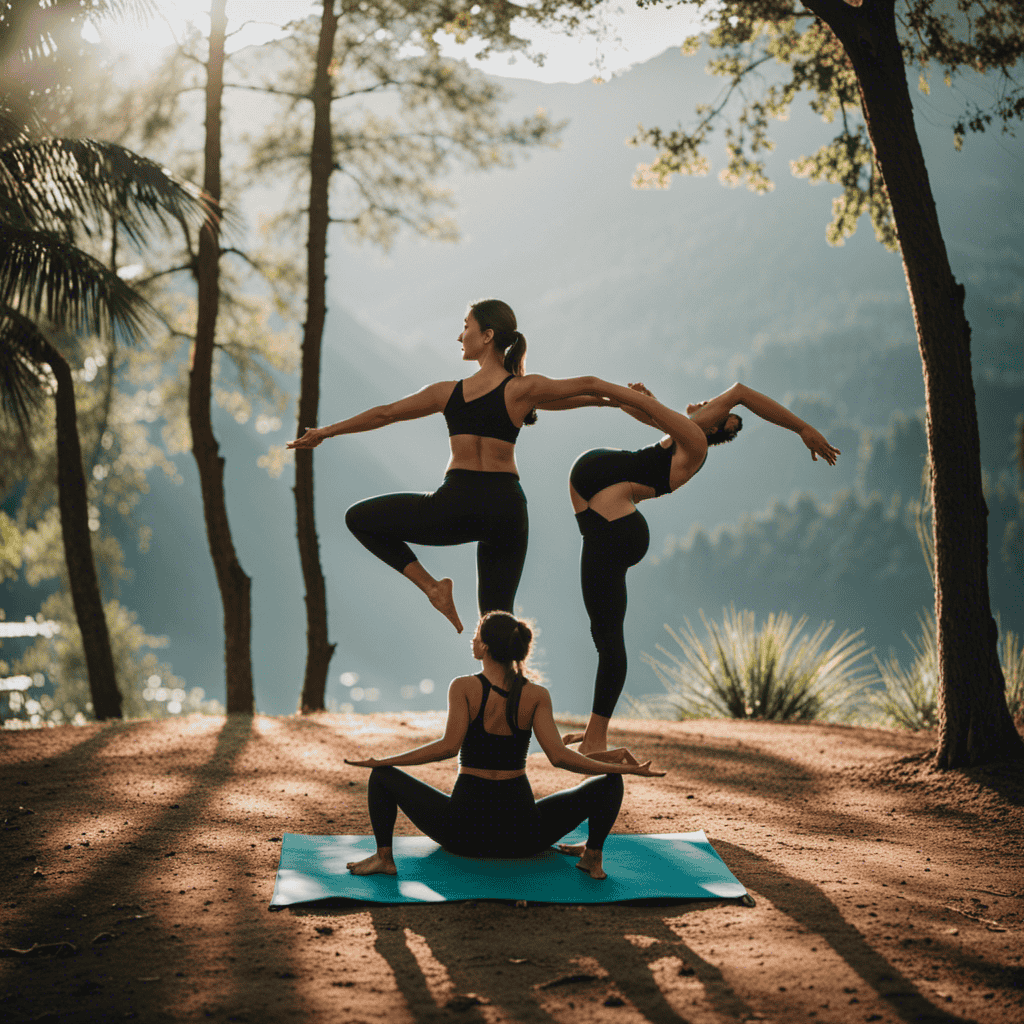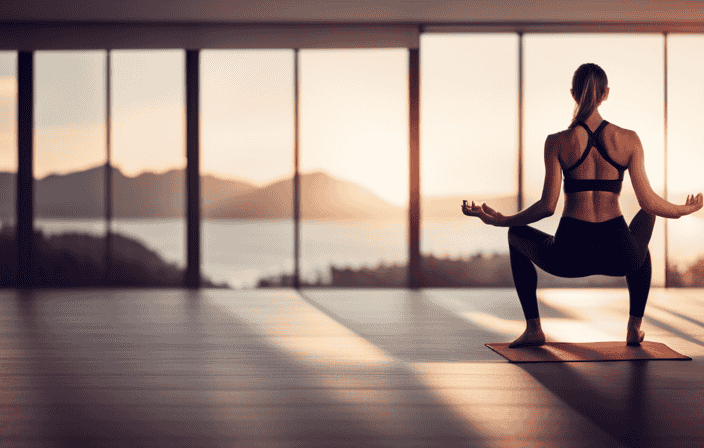The significance of yoga in physical therapy extends beyond just relaxation; it transforms the recovery process. Through integrating yoga’s traditional techniques into physical therapy sessions, patients can enjoy expedited healing and enhanced overall health.
From enhanced joint range of motion to reduced pain and increased strength, the combination of yoga and physical therapy offers a holistic approach to rehabilitation.
In this article, we explore the undeniable benefits of yoga in physical therapy, shedding light on the transformative power of this ancient practice.
Get ready to embark on a journey of accelerated recovery and renewed vitality.
Key Takeaways
- Yoga combined with physical therapy can speed up recovery.
- Yoga enhances pain relief, particularly postoperative pain.
- Including yoga in physical therapy improves joint range of motion.
- Yoga promotes relaxation of the autonomic nervous system (ANS) for psychological healing.
Yoga Origins and Components
I’ve learned that yoga originated in Northern India over 5,000 years ago. It combines physical poses, deep breathing, and concentration.
Yoga is a practice that focuses on the integration of mind, body, and spirit. The physical poses, known as asanas, are designed to strengthen and stretch the body while promoting balance and flexibility.
Deep breathing techniques, such as pranayama, are used to calm the mind and increase oxygen flow throughout the body. Concentration and mindfulness are also essential components of yoga, as they encourage individuals to be present in the moment and cultivate a sense of inner peace.
Research has shown that yoga can have numerous physical and mental health benefits. This makes it a valuable addition to physical therapy treatments.
Benefits of Yoga and Physical Therapy
The combination of yoga and physical therapy offers numerous benefits, including improved balance, flexibility, and strength. When these two practices are combined, they work synergistically to enhance physical and mental well-being. Here are four key benefits of incorporating yoga into physical therapy:
-
Pain relief: Slow stretches in yoga help reduce pain by promoting relaxation and releasing tension in the body. This is especially beneficial for individuals dealing with postoperative pain or chronic conditions.
-
Joint range of motion: Yoga poses improve joint flexibility, allowing for increased mobility and range of motion. This is particularly helpful for individuals with joint pain, stiffness, or reduced range of motion.
-
Mental health: The mind-body connection in yoga helps relieve anxiety, reduce stress, and improve sleep. By promoting relaxation of the autonomic nervous system, yoga aids in psychological healing and enhances overall well-being.
-
Recovery rate: Including yoga in physical therapy enhances the recovery rate by improving strength and aiding in regaining muscle function. The combination of physical therapy exercises and yoga poses increases blood flow, oxygen supply, and essential substances needed for metabolism, promoting faster healing and recovery.
The incorporation of yoga into physical therapy provides a comprehensive and effective approach to rehabilitation, promoting overall wellness and improved functioning of the body.
Yoga as a Complement to Physical Therapy
Incorporating yoga as a complement to my physical therapy sessions has greatly improved my overall well-being and rehabilitation progress. I have experienced firsthand the numerous benefits of combining these two practices. Not only has yoga helped to reduce my pain and improve my joint range of motion, but it has also promoted relaxation of my autonomic nervous system, allowing for psychological healing. By incorporating yoga into my physical therapy routine, I have seen an acceleration in my recovery rate.
The table below highlights the specific benefits of incorporating yoga into physical therapy:
| Benefits of Yoga as a Complement to Physical Therapy |
|---|
| – Reduces pain and improves joint range of motion |
| – Promotes relaxation of the autonomic nervous system |
| – Enhances overall well-being and rehabilitation progress |
Through this combinative approach, I have witnessed firsthand the effectiveness of yoga as a powerful tool for pain relief and physical rehabilitation. By integrating yoga into my physical therapy sessions, I have experienced improved wellness and functioning of major organs, as well as increased strength and flexibility in my joints. This holistic approach has truly accelerated my recovery journey.
Enhanced Pain Relief with Yoga
By incorporating yoga into my physical therapy routine, I have experienced enhanced pain relief and improved overall well-being. The combination of physical therapy and yoga has proven to be incredibly effective in managing and reducing pain.
Here are four reasons why yoga has enhanced my pain relief:
-
Deep relaxation: Yoga promotes the relaxation of the autonomic nervous system, allowing for psychological healing and stress reduction.
-
Increased flexibility: Through gentle stretching and poses, yoga improves joint range of motion, reducing stiffness and pain.
-
Mind-body connection: Yoga focuses on deep breathing and concentration, which helps me stay present and mindful, reducing pain perception.
-
Holistic approach: Yoga not only addresses physical pain, but also enhances mental health, reducing anxiety and improving sleep.
By incorporating yoga into my physical therapy routine, I have not only accelerated my recovery, but also experienced enhanced pain relief and improved overall well-being.
Improved Joint Range of Motion
Improved joint range of motion has been a significant benefit I’ve experienced through the combination of yoga and physical therapy. The incorporation of yoga poses into my physical therapy sessions has allowed me to regain flexibility and mobility in my joints.
Through consistent practice, I’ve noticed a remarkable improvement in my ability to move my joints freely and without pain. Yoga’s emphasis on stretching and gentle movements has helped increase the range of motion in my joints, allowing me to perform daily activities with greater ease.
The combination of physical therapy exercises and yoga poses has provided a comprehensive approach to improving joint function. This enhanced range of motion has not only contributed to my physical recovery but has also improved my overall quality of life.
Relaxation of the Autonomic Nervous System
Through the combination of yoga and physical therapy, I have experienced a profound sense of relaxation in my autonomic nervous system. The practice of yoga promotes the activation of the parasympathetic branch of the autonomic nervous system, which is responsible for the body’s relaxation response. This activation leads to a decrease in heart rate, blood pressure, and levels of stress hormones, while increasing feelings of calmness and overall well-being. Physical therapy, on the other hand, focuses on improving physical function and reducing pain. When these two approaches are combined, the benefits are amplified, resulting in a more comprehensive and effective treatment plan.
To better understand the impact of yoga and physical therapy on the autonomic nervous system, consider the following table:
| Yoga and Physical Therapy | Autonomic Nervous System |
|---|---|
| Promotes relaxation | Activates parasympathetic branch |
| Decreases heart rate, blood pressure, and stress hormones | Induces calmness and well-being |
| Enhances overall treatment outcomes | Amplifies the benefits of both approaches |
This evidence-based approach to recovery not only improves physical function but also enhances mental and emotional well-being, making it a valuable tool in the rehabilitation process.
Combined Benefits of Yoga and Physical Therapy
When incorporating yoga and physical therapy together, I have experienced a wide range of benefits that have positively impacted my overall well-being. The combination of these two practices has been incredibly effective in accelerating my recovery process.
Not only does physical therapy provide relief for joint pain, stiffness, and reduced range of motion, but yoga also enhances joint flexibility and promotes relaxation of the autonomic nervous system (ANS). This integrative approach has significantly improved my recovery rate, allowing me to regain strength and mobility at a faster pace.
Additionally, the deep breathing and stretching involved in yoga increase blood flow to target muscles, providing them with the necessary oxygen, minerals, and substances needed for metabolism.
Overall, the combined benefits of yoga and physical therapy have played a vital role in my journey towards optimal wellness.
Additional Applications of Yoga in Physical Therapy
Incorporating yoga into my physical therapy routine has expanded my understanding of its applications beyond just improving flexibility and relaxation. I have discovered that yoga also plays a crucial role in increasing overall strength.
The deep breathing and stretching involved in yoga poses increase blood flow to target muscles, delivering a greater supply of oxygen, minerals, and substances needed for metabolism. This enhanced blood flow aids in regaining strength during the recovery process.
Additionally, physical therapy encompasses a wide range of health conditions where yoga can be helpful. From joint pain and stiffness to chronic illnesses like diabetes, yoga has proven to be a valuable tool in managing and improving these conditions.
Moreover, the benefits of mindfulness meditation incorporated into physical therapy, as well as the spiritual cleansing aspect, further contribute to the overall recovery journey. Through my personal experience, I have witnessed how the integration of yoga into physical therapy can enhance not only physical wellness but also mental and emotional well-being.
Frequently Asked Questions
How does yoga affect the recovery process in physical therapy?
Yoga enhances the recovery process in physical therapy by improving joint range of motion, promoting relaxation of the autonomic nervous system, and accelerating pain relief, especially postoperative pain. It also improves balance, flexibility, and overall strength.
Can yoga be used as a standalone treatment for pain relief?
No, yoga cannot be used as a standalone treatment for pain relief. While it has many benefits, combining yoga with physical therapy is more effective for pain relief and improving overall wellness and functioning.
What are the specific benefits of combining yoga with physical therapy?
Combining yoga with physical therapy offers numerous benefits. It improves pain relief, joint range of motion, and relaxation of the autonomic nervous system. It also enhances recovery rate and overall wellness.
Are there any potential risks or contraindications to incorporating yoga into physical therapy?
Incorporating yoga into physical therapy can have numerous benefits, but it is important to consider potential risks and contraindications. Factors such as individual limitations, specific medical conditions, and proper guidance from a qualified professional should be taken into account.
How does yoga promote relaxation of the autonomic nervous system and contribute to psychological healing in physical therapy?
Yoga promotes relaxation of the autonomic nervous system (ANS) by activating the body’s relaxation response. This helps reduce stress, anxiety, and pain, contributing to psychological healing in physical therapy.









